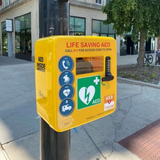Do you know all about your pulse?
Everyone knows what a pulse is, from a young age we have seen on television that holding two fingers on somebodies wrist can help determine if there is blood flowing and that there is a pulse. It seems pretty straightforward stuff however, with medical advances getting better each year and previously life threatening conditions such as arrhythmias (irregular heart beat) now becoming more manageable, it is really important to know how to properly check your pulse so that you can check for any irregularities and get the appropriate care.
How will knowing my pulse help to keep me healthy?
In the UK, 100,000 people die every year after suffering from a sudden cardiac arrest. These are caused by arrhythmias which more than three million British people suffer from. With heart rhythm disorders being the UK’s biggest killer it’s quite shocking that not as much is known about it when compared to other illnesses such as cancer and AIDS.
There are a number of arrhythmias, with the most common being Atrial Fibrillation (AF). AF is a condition which causes the heart to beat irregularly or rapidly and whilst in itself is not dangerous, if left undiagnosed and untreated, can cause conditions such as a stroke or heart failure. Around 1.2 million people in the UK have AF therefore, diagnosing it early can really help to reduce any fatalities associated with it.
Following preventative measures such as diagnosis and therapy can mean that a heart rhythm disorder can be avoided. But, you are probably thinking, how will I know if I have a disorder? One indicator of a heart rhythm disorder is if you have unexplained loss of consciousness. Getting this looked at could help you identify if you do have an arrhythmia and in turn get the correct treatment to help you.
How can I learn my pulse?
The best way to determine whether you have an arrhythmia is to feel for your heart rhythm to detect whether you think it may be too slow, too fast or uneven. To do this, place two fingers over your bone on your wrist at the bottom of your thumb, making sure you don’t put your fingers on your thumb as this has a pulse of it’s own.
Lightly press down on your wrist until you can feel your pulse, don’t worry if you can’t feel it, try pressing a little harder or move your fingers around slightly until you can pick it up.
Once you have found your pulse, count the number of beats that you can feel in fifteen seconds then multiply this by four - this tells you your average number of beats per minute.
For most adults, a normal resting heart rate is between 60 and 100 beats per minute. The more physically fit you are, the lower this number will be, for example, athletes may have an average heart rate of 40 to 60 beats per minute.
Although the span of a normal resting heart rate does seem quite large, having an unusually high or unusually low heart rate is an indicator that it needs looking at. You can speak to your doctor if you feel as though your heart rate is continuously under 40 beats per minute or over 120 beats per minute.
Recent Posts
-
Empowering Communities: The Lifesaving Impact of CPR on Restart a Heart Day
Every year, on and around October 16th, an important event takes place - Restart a Heart Day. This a …16th Oct 2023 -
Which home defibrillator?
80% of all out of hospital cardiac arrests occur at home. Defibrillators are often available in loca …4th Dec 2022 -
Which defibrillator should I buy?
There are many defibrillators available on the market and it can become overwhelming knowing which o …4th Nov 2022




